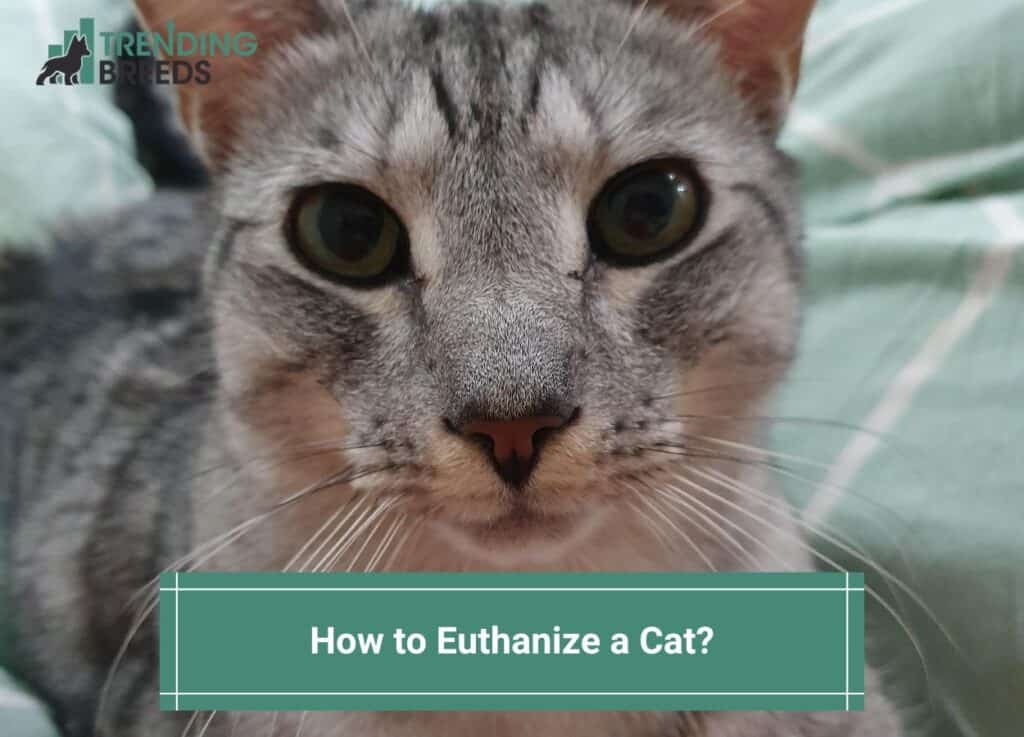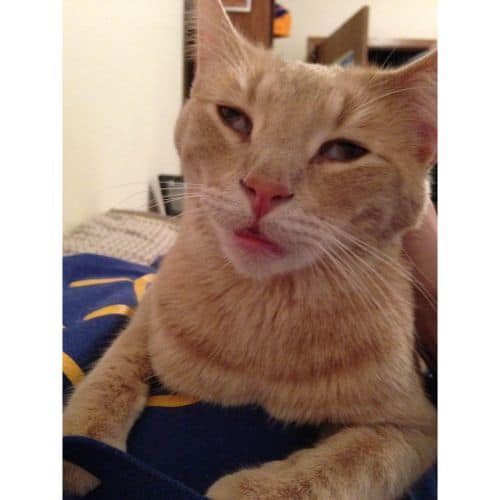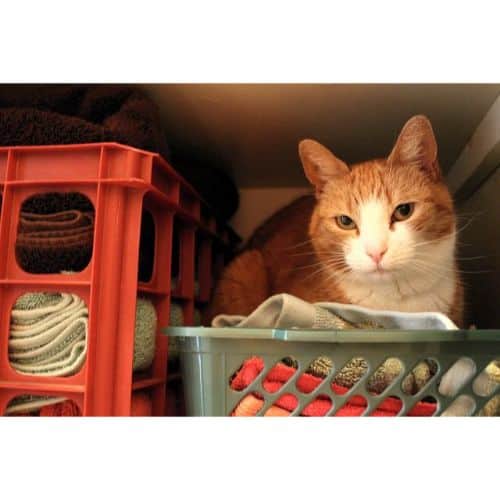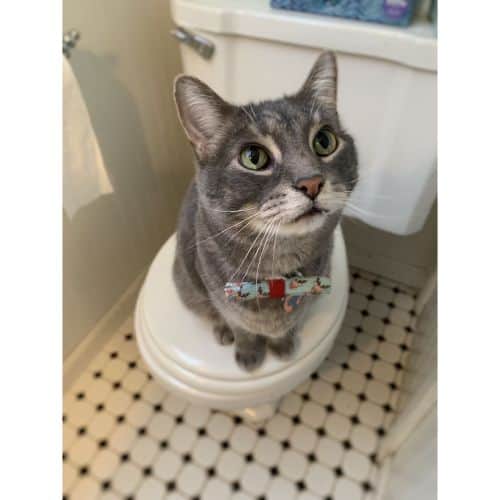
As unfortunate as it is, many pet owners must consider other things, like finances, before deciding to euthanize their cat. If you’re wondering how to euthanize a cat, you might want to consult a vet first.
In such cases, some pet owners might even consider euthanizing their cat themselves.
While the typical euthanasia procedure is quite simple, starting with an anesthetic and intravenous euthanasia medicine, it’s not recommended to euthanize your pet on your own.
In some states, it may even be illegal.
Read below as we discuss how to euthanize your cat in more detail.
Before you scroll further down this guide, check out these other cat-related articles: What Is a Cow-Hocked Cat? and How To Put Your Cat on A Diet?.
Table of Contents
When Is It Time to Euthanize Your Cat?

Even when working closely with a veterinarian and taking their advice through this trying time, signs point to it being necessary to put the animal to sleep.
It is important to keep in mind that the only time euthanasia is an option for a pet cat is if the animal is in excruciating pain and cannot have a good quality of life.
This procedure will, therefore, aid in alleviating their suffering.
Some of the most obvious signs include:
- The cat is forced to give up most of the activities it once enjoyed. You may have noticed that your pet has lost interest in the things it once loved, such as treats, walks, games of nice belly rubs, or even demanding affection from its favorite family member.
- The cat could get so weak that it loses the strength to stand up, and if it does try to walk, it could fall over. This fragility results from the cat’s poor eating habits, which could be due to illness or aging.
- The animal is beginning to breathe more laboriously and severely. These pets have difficulty breathing and may even tend to cough.
- The loss of appetite causes the animal to become malnourished and even weaker. If the cat doesn’t eat anything, not even its favorite kind, it may only be force-fed.
- The household cat frequently suffers from diarrhea and sometimes even throws up. Dehydration or weight loss may follow this excessive water loss.
- There are ongoing pains that the pet cat is experiencing that no amount of medication has been able to stop or control.
- The elderly or ill animal eventually reaches the point when it cannot control its bladder or bowel movements and accumulates dirt all over its furry body.
The Typical Euthanasia Procedure

Take some time off from work to focus on improving after what happened.
If you tell the receptionist the nature of your visit to the clinic or hospital, they will likely schedule your appointment when you have some privacy.
Bringing a close friend or family member along might be a great boost to your confidence. There are vets available who will travel to your house if needed.
You are welcome to see your pet at the hospital one last time if they are still there.
However, it may be more humane to agree to euthanasia while your cat is under anesthesia and not wake him up so that you can say goodbye.
Here is a quick rundown of the steps involved in a typical euthanasia procedure:
Remember that your cat could soon lose consciousness and may no longer be able to feel pain when any of the events described below occur, so try to remain as calm as possible.
In most situations, you will be required to sign a consent document.
A lethal dose of anesthesia is often injected into a vein in the front leg, though other sites on the body may be used.
A small section of the cat’s fur is shaved off while the nurse holds the animal.
Your animal companion could feel a little pinch from the needle, but the injection itself will not be uncomfortable for them in any way.
Both of these anesthetics cause a momentary dizziness as the medication begins to take effect, which may result in the cat letting out a little scream when the injection is given.
The cat falls unconscious rapidly, even before the injection is finished being given. After their heartbeat stops completely, It takes a few minutes for the cat to die.
It could take a little longer if the animal is ill or has a poor respiratory rate. Under these circumstances, it’s probable that the veterinarian won’t be able to locate a vein at all.
If a cat is anxious or fidgety, the veterinarian may choose to start by giving it a sedative; however, because it may be difficult to find a vein, the injection may take more time to complete.
You might observe involuntary muscle movements or gasps in the minutes following death.
These aren’t signs of life; they’re reactions to impending death. The eyes are usually open, and urination occurs intermittently.
The great majority of euthanasia procedures are painless and quick.
Even if complications arise, a quick procedure can save your cat from suffering for days or weeks before dying.
How to Euthanize a Cat

There are some preparations that need to be made in advance if you choose to euthanize your cat in the comfort of your own home.
Start by gathering your equipment, including gloves, gauze, and an injection syringe or needle.
A phone is also helpful, so you can contact your vet for advice when you need it.
As soon as you’re ready, take your cat to a calm spot where it can lie on its side or stomach.
The first step is to provide an intravenous sedative injection to put the cat to sleep.
The cat will feel more at ease and peaceful after doing this. Benadryl, xylazine, ketamine, Xanax, and other sleep medications account for most sedative medications prescribed today.
After administering a sedative to the cat, the euthanasia medication will be administered through injection.
This solution is a fatal dose of medication that will stop the cat from breathing and its heart from beating. Pentobarbital is the drug of choice for euthanasia.
When administered in appropriate amounts, it stops the heart and respiration immediately.
It is common practice to inject the euthanasia solution into the cat’s vein in the leg.
Within minutes, the cat will go comatose and pass away.
Holding them gently while injecting the drug into their vein (often placed behind the front leg) is necessary.
Most cats only need a few minutes to pass after receiving the injection, so ensure they’re as comfortable as possible.
Is it Safe to Euthanize My Cat with OTC Drugs?

Maybe you’ve read up on how to put down a cat with OTC medications or how to put down a cat at home with Tylenol PM.
Although it is possible to end a cat’s life with an overdose of several over-the-counter medications, including Tylenol, Benadryl, and aspirin, it isn’t easy to manage the dose to achieve the intended outcome.
When attempting to use these medications at home, choosing the wrong dose can induce adverse side effects, including the following:
- Seizures
- Vomiting
- Unnecessary pain
In most places, the euthanasia of companion animals is subject to stringent regulations.
If you try to euthanize your cat at home, you risk breaking the law.
The only way to legally put down a pet is to have it done by a veterinarian or another certified expert, either alone or under their watchful eye.
Using Sleeping Pills for Euthanasia

One of the various methods that can be utilized to ensure a painless passing for the cat is the administration of sleeping drugs.
Pentobarbital sodium is a common ingredient in sleeping medications. The anesthetic properties of this sleep medication are well known.
Government drug agencies have also cleared the medication for use in euthanasia.
There are primarily two ways to provide these medications to a pet cat. Barbiturates can be administered orally or intravenously.
While it is possible to euthanize a cat with just sleeping pills, experts recommend administering a dose of sedatives to ensure the cat’s peaceful passing.
The administration of injectable or oral barbiturates is likely to produce pain in the animal.
Sedatives given to the cat play an essential role in easing its anxiety.
However, not every sedative is a good idea. If you want to be sure your pet is safe, it’s important to get advice from a vet professional about the right dosage and medication to use.
The process of euthanizing a cat with sleeping medications takes very little time.
After receiving the sedative, the pet will remain calm and unconscious within five to ten minutes.
After receiving an anesthetic injection, the cat has around thirty minutes before their brain completely shuts down, and their breathing becomes erratic and eventually stops.
The heart rate gradually decreases and eventually stops for one to three minutes.
After their pet passes away, owners are responsible for burying or otherwise properly disposing of their animal.
Cremation and burial are the two most popular methods of final burial.
If you’re considering burial, you will likely own land or have access to land where you can bury your pet.
Digging a hole deep enough so that predators can’t see, smell, or attack the body is also a challenging physical activity.
However, cremation is less complicated and more popular. The ashes of the pet are either brought inside and kept as a memento or left outside.
Risks of Using Over-the-Counter Drugs for Euthanasia

There are a few reasons why it’s not a good idea to do cat euthanasia on your own:
1. Possible Side Effects
Over-the-counter medicine use has a high risk. It’s challenging to find the optimal dosage for a painless death.
When people try to put down their cats at home, they often cause distressing or severe side effects before the animal finally dies.
Breathing difficulties, convulsions, stomach ulcers, and abdominal pain are all examples of unwanted side effects.
2. Legalities

Most governments have laws in place that make it difficult to euthanize pets.
Authorities typically require certified veterinarians or other trained individuals to give euthanasia medications or supervise the process to safeguard our beloved pets from harm.
In some places, it is illegal to euthanize a cat yourself with over-the-counter medication.
3. Better Alternatives
Over-the-counter medications aren’t safe or effective for euthanasia.
Choosing a pharmaceutical medicine like Tylenol or Benadryl to euthanize a cat at home is a deliberate act of harm.
The administration of reliable euthanasia medicines is best left to trained medical personnel in a sterile setting due to potential complications.
There are ways to cut costs (if that’s an issue) without compromising security.
Is It Legal to Euthanize a Cat at Home by Yourself?

Most states only allow licensed veterinarians or others with special training to euthanize animals with barbiturate medicines.
Legally, you can’t put your cat to sleep with an over-the-counter medicine like Benadryl or Tylenol.
Home euthanasia may be legal in some jurisdictions, but only if performed or overseen by a medical expert.
Review the AVMA’s State Animal Euthanasia Laws chart to learn more about the regulations concerning cat euthanasia in your area.
How to Euthanize a Cat?

The standard euthanasia procedure is pretty simple. But euthanizing your cat yourself puts it at risk of complications or unnecessary pain before it passes away.
If finances are an issue, consider looking for low-cost euthanasia options near you.
If you find this guide, “How to Euthanize a Cat,” informative and helpful, you can check out these other cat-related articles from our team:
- Why Is My Cat Scared Of Something I Can’t See?
- How Do I Know If My Cat Is Cold?
- How To Drain A Cyst On Your Cat
You can learn more about this topic by watching “Cat Euthanasia” down below:




